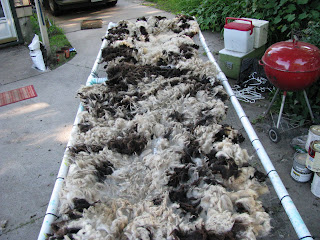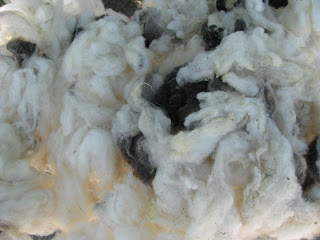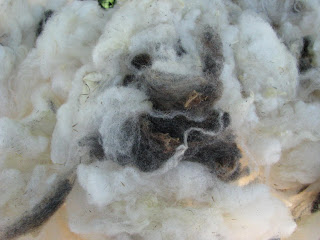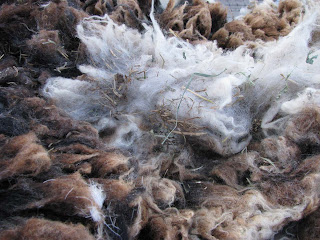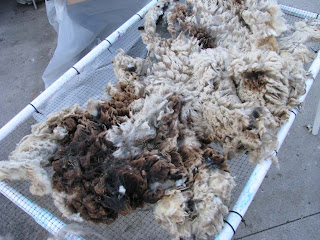I'm off to wash fleeces, Jacob to be exact. I was supposed to do this last year but it never stopped raining long enough to get it done and then life got hectic so... Looks like I will have a three day window to wash some wool and hopefully get some dye pots going as well.
Today
I spent the bulk of today in the garden, it's suppose to rain through Tuesday after that I'm' hoping to wash my jacob fleeces.
Logwood dyed Jacob Fleece
 Two different colors here Above: a grape color using logwood purple. Below: Dark Violet using logwood purple, the bottom fleece is the black AND the white areas of the fleece dyed and bundled together. It would be TOO much work to seperate out the black from the white in the fleece below, it would make a wonderfully mottled or varigated yarn. Available in my Etsy Boutique
Two different colors here Above: a grape color using logwood purple. Below: Dark Violet using logwood purple, the bottom fleece is the black AND the white areas of the fleece dyed and bundled together. It would be TOO much work to seperate out the black from the white in the fleece below, it would make a wonderfully mottled or varigated yarn. Available in my Etsy Boutique Lock lenght is approximately 3 - 3.5 inches.
Lock lenght is approximately 3 - 3.5 inches.
 There are probably some double cuts left in this fleece, there shouldn't be much though I think the person doing the shearing might have been tired by the time he got to this ram, number 30 in the flock. There is also vegetable matter in this fleece which will come out during the carding process. Available in my Etsy Boutique
There are probably some double cuts left in this fleece, there shouldn't be much though I think the person doing the shearing might have been tired by the time he got to this ram, number 30 in the flock. There is also vegetable matter in this fleece which will come out during the carding process. Available in my Etsy BoutiqueI've kept a portion of this fleece for myself and have carded it up already on my drum carder it is divine!
Logwood Dyed Jacob Fleece
Logwood Purple
 The dyed wool air drying out on the skirting table. This table is 4 x 16 feet, each section being 4 x 8 feet. This allows me to lay out a whole fleece and be selective in the skirting process.
The dyed wool air drying out on the skirting table. This table is 4 x 16 feet, each section being 4 x 8 feet. This allows me to lay out a whole fleece and be selective in the skirting process. I'm not sure why the color in the photo below came out so grayed as the wool wasn't this color! This was pre-rinsing. The shot above is after rinsing and while the wool is drying out on the skirting table.
I'm not sure why the color in the photo below came out so grayed as the wool wasn't this color! This was pre-rinsing. The shot above is after rinsing and while the wool is drying out on the skirting table. I've been working on this Jacob fleece for a couple of days now and I have to say the purple turned out devine! I can't wait to card some of this up and give it a spin on the ole spinning wheel. I'll have to dye some silk carrier rods to go with for creating a small bit of art yarn for a yet to be determined project - say like faerie hair! I have more fleece in an alum vat and will put it on to dye tomorrow.
I've been working on this Jacob fleece for a couple of days now and I have to say the purple turned out devine! I can't wait to card some of this up and give it a spin on the ole spinning wheel. I'll have to dye some silk carrier rods to go with for creating a small bit of art yarn for a yet to be determined project - say like faerie hair! I have more fleece in an alum vat and will put it on to dye tomorrow.3 yo Jacob Fleeces
Jacob Wool
Jacob Fleeces
I managed to clean half of a Jacob fleece today, if it doesn't rain tomorrow I will clean the remaining half. I plan to dye it with madder root when done with this particular fleece, I'll pull the brown/black areas out and set them aside for when I have more of the black color.
Wool Rant 2008
 Dirty side of the Jacob fleece, filled with cockle burrs, grass, or hay, from improper feeding and pasture care. I intentionally left the picture files large so you could click on them and see the detail areas of the fleece.
Dirty side of the Jacob fleece, filled with cockle burrs, grass, or hay, from improper feeding and pasture care. I intentionally left the picture files large so you could click on them and see the detail areas of the fleece.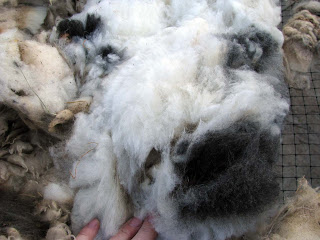 The cut or clean side of the same fleece, see the potential!
The cut or clean side of the same fleece, see the potential!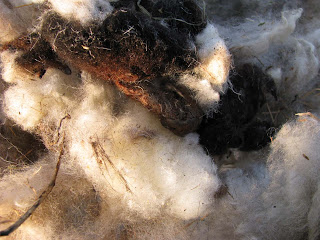 Dingle berry, or turd, either way it should have been removed BEFORE the fleece was put into the bag.
Dingle berry, or turd, either way it should have been removed BEFORE the fleece was put into the bag. Cockle burrs, gazillions of them, and this pasture was reportedly clean of burrs, a little bit of round up would be a blessing in this pasture! Or a teenager with a weed hook, whichever the farmer wishes to do, but burrs seriously decrease the value of ANY wool fleece. I'll spend hours picking the burrs out of this fleece to get it ready for market.
Cockle burrs, gazillions of them, and this pasture was reportedly clean of burrs, a little bit of round up would be a blessing in this pasture! Or a teenager with a weed hook, whichever the farmer wishes to do, but burrs seriously decrease the value of ANY wool fleece. I'll spend hours picking the burrs out of this fleece to get it ready for market.  Hay was fed to the sheep in big round bales, well sheep like to rub against objects to scratch an itch and this is the end result, lots of vegetable matter (VM) in the fleece, again many hours of cleaning this to make it ready for market.
Hay was fed to the sheep in big round bales, well sheep like to rub against objects to scratch an itch and this is the end result, lots of vegetable matter (VM) in the fleece, again many hours of cleaning this to make it ready for market.



